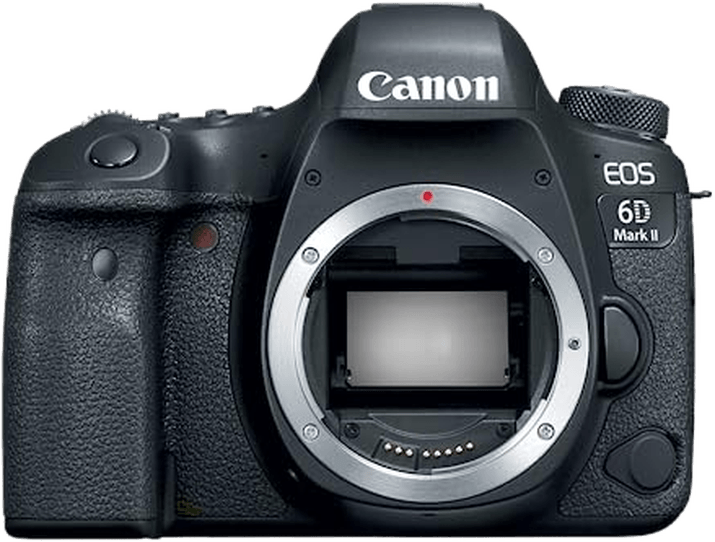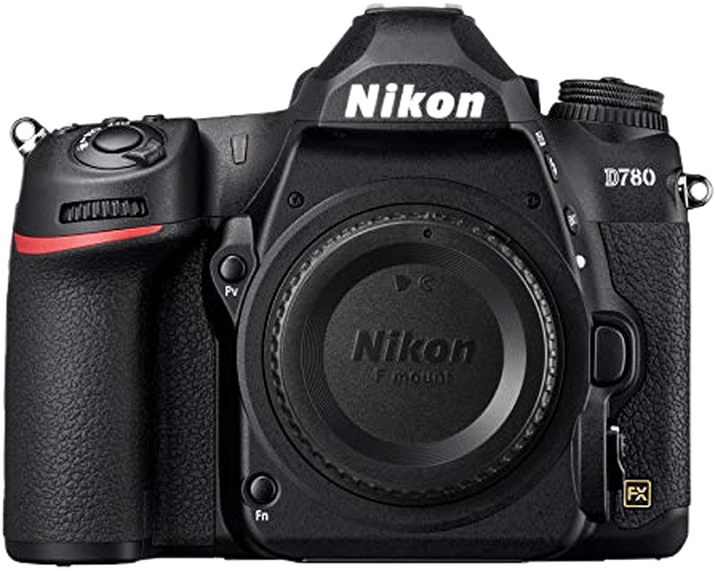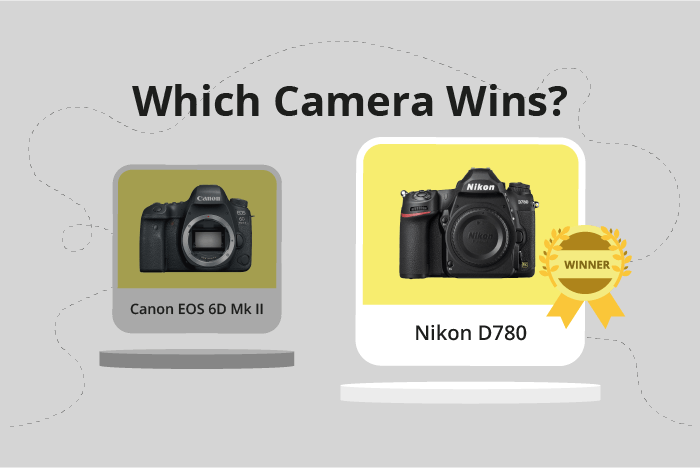Canon EOS 6D Mark II vs Nikon D780 Comparison
Canon EOS 6D Mark II

Nikon D780

The Nikon D780 triumphs over the Canon EOS 6D Mark II with a score of 81/100 compared to the latter’s 71/100. Both cameras are DSLRs, released in 2017 and 2020, respectively. They share similar dimensions, with the Canon measuring 144 x 111 x 75mm and the Nikon at 144 x 116 x 76mm. However, the Canon is significantly lighter at 453g, while the Nikon weighs 850g.
The Nikon D780 excels with better overall performance, justifying its higher price tag of $2299 compared to the Canon’s $2000. On the other hand, the Canon EOS 6D Mark II offers a more budget-friendly option without compromising on quality. Its lighter weight also makes it more convenient for extended use.
Considering the scores and specifications, the Nikon D780 is the superior camera, but the Canon EOS 6D Mark II remains a strong contender for those seeking a more affordable and lightweight option.
Canon EOS 6D Mark II vs Nikon D780 Overview and Optics
The Nikon D780 outperforms the Canon EOS 6D Mark II in optics with a score of 77/100 compared to 69/100. Both cameras share some common specifications, such as full-frame CMOS sensors, no image stabilization, and similar megapixel counts (25 for the Nikon and 26.2 for the Canon).
The Nikon D780’s superiority is evident in its faster shooting speed of 12 frames per second, compared to the Canon’s 6.5. This allows the Nikon to capture fast-moving subjects more effectively. Additionally, the D780’s Expeed 6 processor contributes to better image quality and faster performance than the Canon’s Digic 7 processor. The Nikon also boasts a higher DXOMARK sensor score of 97, indicating better overall image quality and low-light performance than the Canon’s score of 85.
The Canon EOS 6D Mark II, however, has a slight advantage in megapixels, with 26.2 compared to the Nikon’s 25. This difference may result in marginally higher resolution images, but it is not significant enough to impact overall performance or image quality.
Both cameras utilize their respective brand’s lens mounts, with the Canon using the EF mount and the Nikon using the F mount. This allows users of either camera to take advantage of a wide range of lenses and accessories from their respective manufacturers.
In comparing the optics of the Canon EOS 6D Mark II and Nikon D780, it is clear that the Nikon emerges as the winner, providing faster shooting speeds, a better processor, and superior image quality. While the Canon does have a slight edge in megapixels, this difference is not significant enough to outweigh the advantages offered by the Nikon D780.
Canon EOS 6D Mark II vs Nikon D780 Video Performance
The Nikon D780 clearly outperforms the Canon EOS 6D Mark II in video capabilities with a score of 91/100, while the Canon has a score of 57/100. Both cameras share some common specifications, such as having built-in time-lapse functionality. However, the Nikon D780 has superior specifications that contribute to its higher score.
The Nikon D780 excels with its 4K video resolution and dimensions of 3840 x 2160, compared to the Canon EOS 6D Mark II’s Full HD resolution and dimensions of 1920 x 1080. This means that the Nikon D780 can capture videos with higher clarity and detail. Additionally, the Nikon D780 has a maximum video frame rate of 120fps, which allows for smoother video playback and slow-motion effects. In contrast, the Canon EOS 6D Mark II has a maximum frame rate of 30fps, limiting its ability to capture fast-moving subjects.
Despite having a lower score, the Canon EOS 6D Mark II still offers decent video capabilities with Full HD resolution and time-lapse functionality. However, its lower video frame rate and resolution make it less versatile than the Nikon D780 for videographers who demand higher quality and performance.
Considering the significant difference in video scores and the superior specifications of the Nikon D780, it is evident that the Nikon D780 is the better choice for those prioritizing video capabilities. The Canon EOS 6D Mark II remains a viable option for casual video users, but the Nikon D780 offers a more powerful and versatile video experience for those who require higher quality and performance.
Canon EOS 6D Mark II vs Nikon D780 Features and Benefits
The Nikon D780 emerges as the winner in the features comparison with a score of 87/100, while the Canon EOS 6D Mark II scores 83/100. Both cameras share some common specifications, such as a touchscreen, flip screen, WIFI, and Bluetooth connectivity.
The Nikon D780 outperforms the Canon EOS 6D Mark II in certain aspects. Its screen size is larger at 3.2 inches compared to the Canon’s 3-inch screen. Additionally, the D780’s screen resolution is significantly higher at 2,359,000 dots, whereas the 6D Mark II has a resolution of 1,040,000 dots. This difference in screen size and resolution allows for better image preview and easier menu navigation on the Nikon D780.
However, the Canon EOS 6D Mark II has an advantage over the Nikon D780 in terms of GPS functionality. The 6D Mark II comes with built-in GPS, which the Nikon D780 lacks. This feature enables photographers to geotag their images, providing location information and enhancing their organization capabilities.
Taking these points into consideration, the Nikon D780 proves to be a better camera in terms of screen size and resolution, offering superior image preview and navigation experience. On the other hand, the Canon EOS 6D Mark II offers the added benefit of GPS functionality for location-based photography. Depending on the user’s priorities and preferences, either camera can be a suitable choice. However, the Nikon D780’s higher feature score indicates a slight edge over the Canon EOS 6D Mark II.
Canon EOS 6D Mark II vs Nikon D780 Storage and Battery
The Nikon D780 emerges as the winner in storage and battery, with a score of 97, while the Canon EOS 6D Mark II scores 45. Both cameras have memory card slots, accepting SD, SDHC, and SDXC cards. However, the D780 has two card slots and supports faster UHS-II compatibility, compared to the 6D Mark II’s single slot and UHS-I compatibility.
The D780’s battery life is significantly longer, providing 2260 shots per charge, whereas the 6D Mark II delivers 1200 shots. Additionally, the D780 uses the EN-EL15b battery type and supports USB charging, while the 6D Mark II relies on the LP-E6N battery without USB charging capability.
Despite its lower score, the 6D Mark II still offers decent storage and battery performance for casual photographers. However, the Nikon D780 clearly outperforms the Canon EOS 6D Mark II in this category, making it a superior choice for those prioritizing storage and battery life.
Canon EOS 6D Mark II vs Nikon D780 – Our Verdict
Are you still undecided about which camera is right for you? Have a look at these popular comparisons that feature the Canon EOS 6D Mark II or the Nikon D780:

